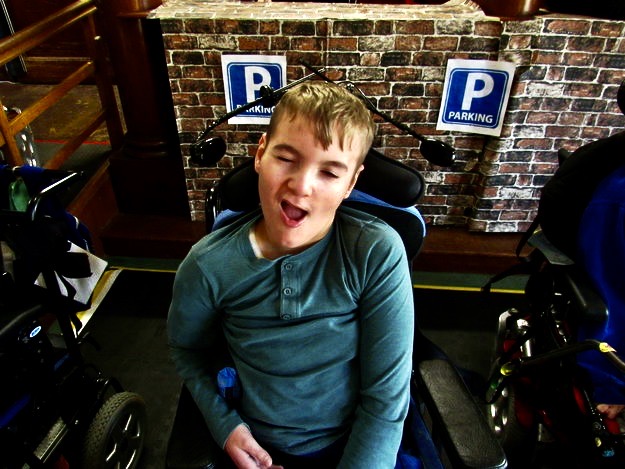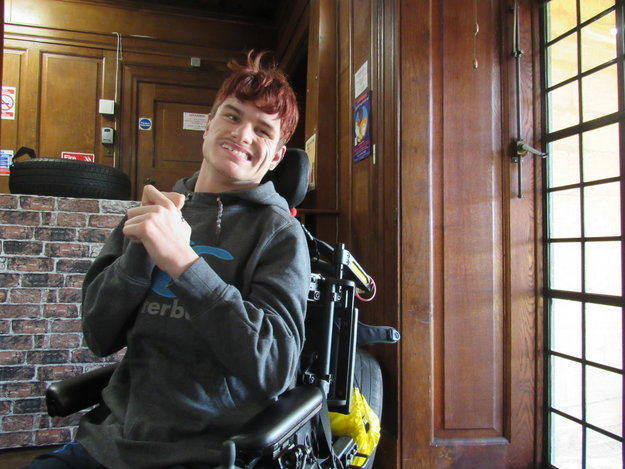Amidst cuts in funding to social care and welfare schemes, a private school in Wales has developed UK’s first wheelchair mobility training facility.

Callum Luce is 17 and wheelchair-ridden, but that barely seems to matter as he whizzes around a vast property nestled in the pristine unfiltered Welsh countryside on the outskirts of Cardiff.
Most of the kids at the Craig Y Parc school use massive contraptions to help them move around independently but, Callum’s chair isn’t as modern and bespoke as the many others that were in view but, his smile while waiting at the fake red-light on the course warrants only one description; priceless. The smile widens as Luke Bacchetta nods approvingly.
Luke, 34 is the Assistant Technologist at the institution and has been working with Craig Y Parc aiding children with disorders like Cerebral Palsy, for the last twelve years. In conversation, he actually plays down his importance in the “birth” of this course.
“It’s all very well, driving in a nice and flat environment when they’re in school, but it would be unfortunate if they weren’t able to transfer those skills when they are in the real world that isn’t ideally designed for disabled people,” says Luke.

Why do we need this facility?
Most of these children will need supervision all their life but it is essential for them to learn to be independent in ways they can be.
Unsurprisingly, amidst excursions to the city, the children have faced a multitude of problems while navigating around despite accessibility for the disabled being better than never before.
Luke recalls a trip to Cardiff Museum, “We were going across the road, the traffic light system is so short that a lot of our students could cross in time. One student, in particular, had to repeatedly reposition his hand after going over the curb. By the time he could put it back on the lights had already changed. He had to repeat this about.”
Ella Marie Rees, 15, Morgan Powell, 14, and Jac Skyrme, 18 along with Callum used my visit as an opportunity to skip out on their regular classes and was brimming with excitement about showcasing their newly practiced skills.
What is the facility all about?
The chairs used by these kids are quite complex pieces of machinery and most of them are not aware of or have no practice using the more niche facilities that may come with it.
The driving school provides an appropriate and safe environment for them to learn to control their vehicle and get acquainted with the variety of terrains that they might face.
“That’s why we have the bumpy road, speed bump, and curb climber, just to get the students used to different textures and obstacles they may face. With practice, they will maintain better contact with their controls and learn techniques that work best for them,” says Luke.
He tells me about a student who toppled off his chair after the wheels slipped off the pavement near his home, and the idea of having pavements lined with white lines as a means to provide the kids with a “visual cue” for guidance dawned on Luke as similar incidents were brought to the forefront by parents.

The whole course is designed with simplicity while a pinch of fun is infused into the daily activity. Luke uses a quirky traffic-offences and ticketing system, that drives the kids into heaps of laughter amidst the process of learning.
Every session caters to three students at a time and begins when they line up in the parking bay. During the first run, most kids pick up three or four tickets and in the following turns, they are trained in those specific mistakes that they made.
What next in terms of further progress?
Success is often immeasurable, but the driving school has been working. “We’ve had calls from parents saying that their driving in the community has been a lot better and just the general overall control and awareness really, of how the students deal with their environment,” says Luke.
He isn’t too critical of the authorities but with a tinge of disappointment in his tone says, “Local Authorities have been cutting funding left, right and centre…Social care is a big area that has been cut…These kids have to get used to new people working with them and when they transition into Adult Services – which isn’t really ideal,” considering how stories of disabled kids after completing college being placed into old people’s homes are part of the discourse.
“I think when they put in legislation for new buildings, they should keep in mind changes to Assistive technology and the increasing sizes of wheelchairs,” says Luke.

The school has plans to expand the driving school using the associations that they have with other similar institutions while broadening their own course; beginning with providing access to the gardens in the summer.
The staff and faculty at the school along with Ambito Education which owns Craig Y Parc, are doing their bit, and more. Governments in the UK should be taking notes.
Accessibility for the disabled in society is better than before, and the next step is to raise awareness about the same so that the needs of the wheelchair-ridden are catered to like never before.
Morgan, when asked about the driving school, takes a while to reply using his monitor, but he jokes, “Terrible!” The mischievous smile he had faded away as Luke tells him that it was time to return to class; but he’ll be back the very next day, with the same roguish smile.
